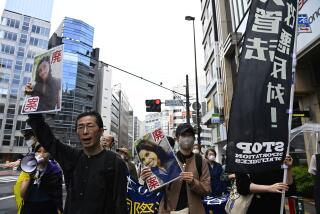Online maps trigger a feudal furor
- Share via
TOKYO — When Google Earth added historical maps of Japan to its online collection last year, the search giant didn’t expect a backlash. The finely detailed woodblock prints have been around for centuries, they were already posted on another website, and a historical map of Tokyo put up in 2006 hadn’t caused any problems.
But Google failed to judge how its offering would be received, as it has often done in Japan. The company is now facing inquiries from the Justice Ministry and angry accusations of prejudice because its maps detailed the locations of former low-caste communities.
The maps date back to the country’s feudal era, when shoguns ruled and a strict caste system was in place. At the bottom of the hierarchy were a class called the burakumin, ethnically identical to other Japanese but forced to live in isolation because they did jobs associated with death, such as working with leather, butchering animals and digging graves.
Castes have long since been abolished, and the old buraku villages have largely faded away or been swallowed by Japan’s sprawling metropolises. Today, rights groups say the descendants of burakumin make up about 3 million of the country’s 127 million people.
But they still face prejudice, based almost entirely on where they live or their ancestors lived. Moving is little help, because employers or parents of potential spouses can hire agencies to check for buraku ancestry through Japan’s elaborate family records, which can span back over a hundred years.
An employee at a large, well-known Japanese company, who works in personnel and has direct knowledge of its hiring practices, said the company actively screens out burakumin job seekers.
“If we suspect that an applicant is a burakumin, we always do a background check to find out,” she said. She agreed to discuss the practice only on condition that neither she nor her company be identified.
Lists of “dirty” addresses circulate on Internet bulletin boards. Some surveys have shown that such neighborhoods have lower property values than surrounding areas, and residents have been the target of racial taunts and graffiti. But the modern locations of the old villages are largely unknown to the general public, and many burakumin prefer it that way.
Google Earth’s maps pinpointed several such areas. One village in Tokyo was clearly labeled eta, a now strongly derogatory word for burakumin that literally means “filthy mass.” A single click showed the streets and buildings that are currently in the same area.
Google posted the maps as one of many “layers” available via its mapping software, each of which can be matched with modern satellite imagery. The company provided no explanation or historical context, as is common practice in Japan. Google’s basic stance is that its actions are acceptable because they are legal, one that has angered burakumin leaders.
“If there is an incident because of these maps, and Google is just going to say ‘it’s not our fault’ or ‘it’s up to the user,’ then we have no choice but to conclude that Google’s system itself is a form of prejudice,” said Toru Matsuoka, a member of Japan’s upper house of parliament.
Asked about its position on the issue, Google responded with a formal statement that “we deeply care about human rights and have no intention to violate them.”
Google spokesman Yoshito Funabashi points out that the company doesn’t own the maps in question, it simply provides them to users. Critics argue that they come packaged in its software, and the distinction is not immediately clear.
Printing such maps is legal in Japan. But it is an area in which publishers and museums tread carefully, as the burakumin leadership is highly organized and has offices throughout the country. Public showings or publications are nearly always accompanied by a historical explanation, a step Google failed to take.
Matsuoka, whose Osaka office borders one of the areas shown, also serves as secretary general of the Buraku Liberation League, Japan’s largest such group. After discovering the maps, he raised the issue to Justice Minister Eisuke Mori on March 17.
Two weeks later, after the public comments and at least one reporter contacted Google, the old maps were suddenly changed, wiped clean of any references to the buraku villages. There was no note made of the changes, and they were seen by some as an attempt to quietly dodge the issue.
“This is like saying those people didn’t exist. There are people for whom this is their hometown, who are still living there now,” said Takashi Uchino from the Buraku Liberation League headquarters in Tokyo.
The Justice Ministry says it is gathering information on the matter, but has yet to reach a conclusion, ministry official Hideyuki Yamaguchi said.
The league also sent a letter to Google, a copy of which was provided to the Associated Press. It wants a meeting to discuss the buraku issue. It says Google should “be aware of and responsible for providing a service that can easily be used as a tool for discrimination.”
An Internet legal expert said Google is quick to take advantage of its new technologies to expand advertising, but society often pays the price.
“This is a classic example of Google outsourcing the risk and appropriating the benefit of their investment,” said David Vaile of the Cyberspace Law and Policy Center at the University of New South Wales in Australia.
More to Read
Sign up for Essential California
The most important California stories and recommendations in your inbox every morning.
You may occasionally receive promotional content from the Los Angeles Times.













